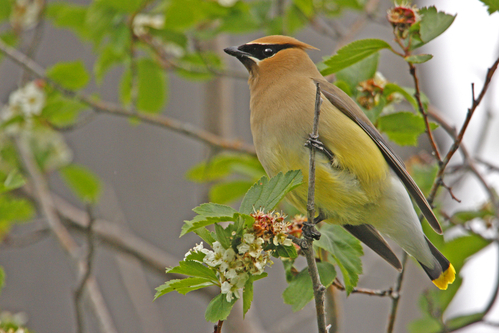
Waxwings are a favorite of many birders and backyard naturalists. Their striking crests and sharp color accents, make them easy to distinguish from the other birds. They get their name from the unique red waxy tip on the end of their wings and a yellow waxy tip on their tails. These red wax-like tips depend on the species, but in the case of the Japanese Waxwing, this trait is often lacking and replaced by bright red or pink spots.
What do they eat?
They eat mostly berries and insects. The majority of their diet is berries and small fruits including juniper, dogwood, and wild cherries. They also sometimes eat certain flowers and have been known to drink oozing sap. They are sometimes considered a pest because a flock of waxwings can remove all buds or fruits of a tree in a few hours or even in a few minutes! During the summertime, they eat many insects including beetles, caterpillars, ants. Young nestlings are fed mostly insects at first, then more berries after several days. Waxwings are some of the only birds known that can live off only fruit for a long period of time. They also are one of the few species of birds that ingest the seeds of the fruit.
Where do they live?
Waxwings are not known for long-distance and consistent migrations, but rather they wander erratically depending on where their next meal is going to be. During the winter months, they frequent a variety of habitats. They can be found in forests, but also in urban areas such as parks and gardens where there are available fruits on trees and other plant species. All three species feed heavily on sugary fruits mainly in autumn and winter, while arthropods are taken mostly during summer. The Cedar Waxwing can be found all across North America from Alaska to parts of Florida. Bohemian Waxwings are more spread out and are seen in southeast parts of North America as well as in Eurasia. The Eurasian birds can be found from eastern Britain through northern parts of western and central Europe, Ukraine, Kazakhstan to northern China to Japan.
What are the different types?
There are only three types of Waxwing species in the world. They are the Cedar Waxwing, the Bohemian Waxwing, and the Japanese Waxwing. They all have a similar distinctive crest on their heads and a smooth silky coat with bright coloration on the tips of their wings and tail. The Japanese Waxwing is the only species that doesn’t have the red wax tips that the birds get their name from.

Bohemian Waxwing
The Bohemian Waxwing is 19–23 cm (7.5–9.1 in) in length and an average weight of 55 g (1.9 oz). It is short-tailed, mainly brownish-grey, and has a noticeable crest on its head. They are known to have a white streak behind the bill and a white curve below the eye with cinnamon-colored areas around the mask.
Japanese Waxwing
The Japanese Waxwing is about 18 cm in length and its plumage is mostly pinkish-brown. It has a pointed crest, a black throat, a black stripe through the eye, a pale yellow center to the belly and a black tail with a red tip. The wings have a pattern of black, grey and white with a reddish-brown stripe running across them.
Unlike the other species of waxwing, it lacks the row of waxy red feather-tips on the wing which gives the birds their name. Japanese Waxwings often occur in mixed flocks with Bohemian Waxwings which, as well as having the row of waxy tips, are slightly larger with a yellow tail-tip, grayish center to the belly and no reddish-brown stripe across the wing.
The Japanese Waxwing can be found in the Russian Far East, north-east China, parts of Korea, and all over Japan. It is at some risk of becoming threatened with extinction due to loss and degradation of its forest habitat.
Cedar Waxwing
Cedar Waxwings are medium-sized birds approximately 6–7 in (15–18 cm) long and weighing roughly 30 g (1.1 oz). They are smaller and browner than their close relative, the Bohemian Waxwing. These birds‘ most prominent feature is this small cluster of red wax-like droplets on tips of secondary flight feathers on the wings, a feature they share with the Bohemian Waxwing but not the Japanese waxwing.
Their markings are a silky, shiny collection of brown, gray, and lemon-yellow, accented with a subdued crest, black mask, and red wax droplets on the wing feathers. Adult males and females look alike while the younger birds are streaked on the throat and flanks, and often do not have the black mask of the adults. The wings are broad and pointed, like a starling’s. The tail is typically yellow or orange depending on diet.
Cedar Waxwings are sociable, seen in flocks year-round. They move from place to place depending on where they can find good sources of berries.
